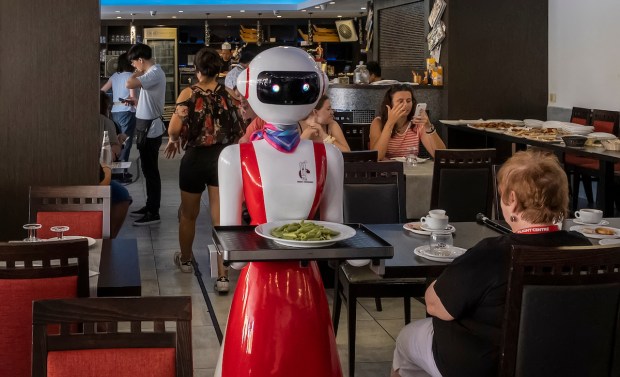Restaurants Go All-In on Smart Digital, but Consumers Remain Wary

Restaurants are increasingly adopting automation, artificial intelligence (AI) and robots across all areas of operation, but these efforts are not always a surefire hit.
A Chick-fil-A in Valrico, Florida, for instance, became one of the most recent restaurants to try drone delivery last week, kicking off automated delivery with DroneUp, per the restaurant’s Instagram post.
Meanwhile, Yum Brands, the parent company of Pizza Hut, KFC, Taco Bell and The Habit Burger Grill, is trying out automated technologies across many parts of its operations, per the quick-service restaurant (QSR) giant’s latest earnings call, including inventory management, voice ordering, drinks fulfillment and delivery sequencing.
Chipotle, for its part, has been testing automated technology to optimize its makelines for eCommerce orders. By leveraging automation, Chipotle aims to increase capacity, improve speed and accuracy, and strike a balance between human labor and robotic assistance. The company has partnered with automated food service platform Hyphen to test a “cobotic” digital makeline, combining robots and human labor to boost efficiency.
Plus, Remy Robotics launched an autonomous ghost kitchen, Better Days, leveraging the efficiency the technology enables to offer fast-fine menu items — higher-quality foods at lower costs. The company uses these capabilities to reach a prime cost of 50%, lower than the typical 60% to 70% in QSRs, as CEO Yegór Traiman told PYMNTS in an interview posted Nov. 15.
Yet automation in restaurants does not always pay off. For instance, in San Francisco, a store that sold AI-generated smoothies closed less than two months after opening, as The Guardian reported.
Moreover, last year, casual dining giant Chili’s halted the rollout of robo-waiters amid parent company Brinker International’s broader reevaluation of its tech initiatives. Yet conversely, Chick-fil-A is only beginning to test out such technologies.
Consumers have their doubts about automation in the restaurant industry. PYMNTS Intelligence’s exclusive report, “Connected Dining: The Robot Will Take Your Order Now,” which drew from a survey of nearly 2,000 U.S. consumers, found that two-thirds are uninterested in robotics or automated systems preparing or cooking food. Plus, 72% of consumers are uninterested in robotics or automated systems delivering food.
Yet automation is already becoming an integral part of the industry. Data cited in the PYMNTS report “Inflation Puts Technology on the Menu for Restaurants,” the June edition of the “B2B and Digital Payments Tracker®,” created in collaboration with American Express, showed that 76% of restaurants are already using automation in at least three areas of operations.
Plus, according to data highlighted in last month’s edition of Digital-First Banking Tracker® Series Report, “The Restaurant of the Future Is Open. Will Diners Bite,” QSRs anticipate that 51% of tasks will be automated by 2025, while full-service restaurants expect to automate 27% of tasks.
Experiences of AI in restaurant technology can be positive, as Paytronix CEO Jeff Hindman told PYMNTS’ Karen Webster in an interview over the summer.
“I had a really fun experience when I first started at the company: The team, to demonstrate some of our AI capabilities and how can we predict what an individual customer’s going to do, showed me my profile as seen through loyalty programs,” Hindman said, noting that the technology calculated the days he would be most likely to make a purchase, among other behavior predictions, with surprising accuracy.
For all PYMNTS AI coverage, subscribe to the daily AI Newsletter.
